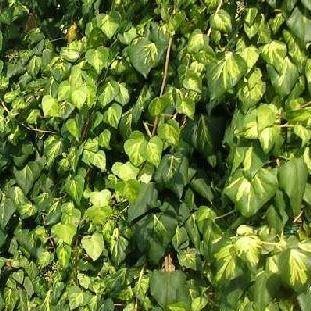
Hedera colchica 'Sulphur Heart'
Colchis ivy
Hedera - Ivy - is an evergreen climbing or ground-creeping woody plant. When creeping, it rarely exceed 20 cm height, but when climbing on suitable surfaces,using specialised hairs that enable it to cling, it can climb to at least 30m above the ground. The leaves of ivy are shiny, dark green (pale green when young) with 3 - 5 lobes.Mature plants produce yellow-green flower-clusters, followed by black berries. All parts of the plant are toxic, and contact with the sap may irritate skin, or cause an allergic reaction.There are many cultivars. This variegated Persian ivy has heart-shaped, mid-green leaves splashed with yellow.
-
Full sun to partial shade
-
Very little water
-
Full Frost Hardy: 5F (-15°C)
-
Moist and free draining
Common name
Colchis ivy
Latin name
Hedera colchica 'Sulphur Heart'
type
Climber
family
Araliaceae
ph
5.0 - 8.0 Acid - Neutral
Plant & bloom calendar
-
Best time to plant
full grown dimensions
 20.00 M
30.00 M
20.00 M
30.00 M
Hedera colchica 'Sulphur Heart'
Hedera - Ivy - is an evergreen climbing or ground-creeping woody plant. When creeping, it rarely exceed 20 cm height, but when climbing on suitable surfaces,using specialised hairs that enable it to cling, it can climb to at least 30m above the ground. The leaves of ivy are shiny, dark green (pale green when young) with 3 - 5 lobes.Mature plants produce yellow-green flower-clusters, followed by black berries. All parts of the plant are toxic, and contact with the sap may irritate skin, or cause an allergic reaction.There are many cultivars. This variegated Persian ivy has heart-shaped, mid-green leaves splashed with yellow.
Planting
From Early Spring TO Early Spring
Ivy is quite adaptable to various garden situations, but it prefers fertile, humusy, moist but well-drained soil. Variegated ivies like light, but need protection from strong sun. Plant deeply to encourage quick establishment. Indoors, provide bright indirect to low light.
Propagation
From Early Spring TO Early Summer
Cut a length of ivy vine up to 4 feet long. Use a clean pair of shears or a sharp knife. Cut the vine into multiple pieces, with each piece having one or two leaves. Make each cut directly above a leaf, and trim the stem below the leaf to about one inch. Dip the end of each stem in rooting hormone powder. Fill a planter with sand (or a sand/soil mix) and poke holes in the sand for planting. Plant each powdered stem in a hole and then gently push the sand around the stem. Water the sand well and place the planter in a plastic bag to help retain moisture. Open the bag once a week to water when needed to keep it moist. The ivy twigs will begin to sprout and be ready to replant in a permanent location within six to eight weeks.







